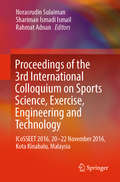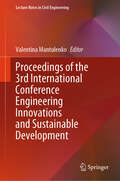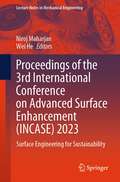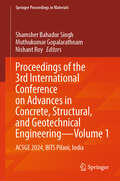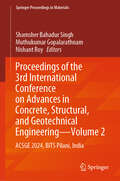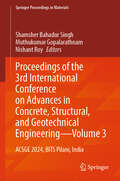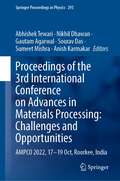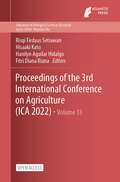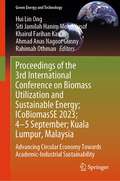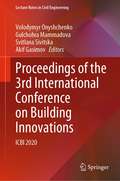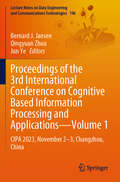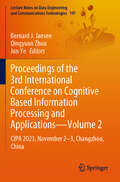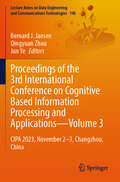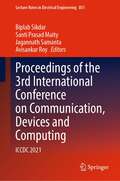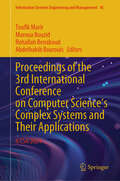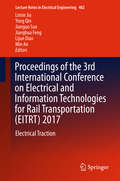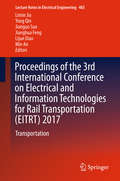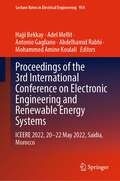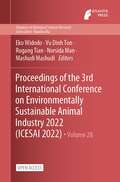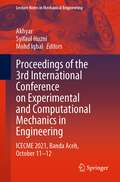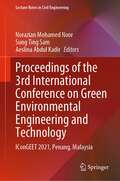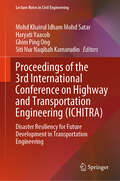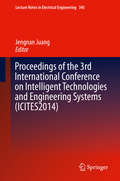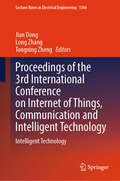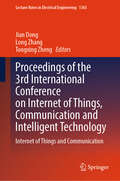- Table View
- List View
Proceedings of the 3rd International Colloquium on Sports Science, Exercise, Engineering and Technology: ICoSSEET 2016, 20-22 November 2016, Kota Kinabalu, Malaysia
by Shariman Ismadi Ismail Norasrudin Sulaiman Rahmat AdnanThis proceedings volume explores a range of sports-related topics, including sports science, exercise, sports engineering and technology, in contributions prepared by respected experts and presented at the 3rd International Colloquium on Sports Science, Exercise, Engineering and Technology (ICoSSEET2016). The goal of the conference was to bring together researchers and practitioners from academia and industry to address current challenges in various sports-related areas, and to establish vital new collaborations. The topics covered can be primarily divided into (1) Sports Science and Exercise, (2) Sports Engineering and Technology Application, and (3) Sports Industry and Management.
Proceedings of the 3rd International Conference Engineering Innovations and Sustainable Development (Lecture Notes in Civil Engineering #540)
by Valentina MantulenkoThis book presents the contributions from the 3rd International Conference Engineering Innovations and Sustainable Development, held in Samara, Russia on April 26, 2024. By presenting international research on various sustainability issues, it includes topics such as current trends in industrial and agricultural development, innovations in the construction and transport sectors, problems concerning the financing of innovative activities and governmental support for innovations, and engineering competences and skills in the era of new technologies. It also covers the economic, environmental, and informational aspects of sustainable development in the context of innovations. Finally, the book addresses theoretical and practical aspects by studying the phenomenon of sustainability and engineering development in terms of comparing international experiences. It provides significant value for scientists, teachers, and students of higher educational institutions, and specialists, who are researching sustainable development issues in the era of engineering innovations.
Proceedings of the 3rd International Conference on Advanced Surface Enhancement: Surface Engineering for Sustainability (Lecture Notes in Mechanical Engineering)
by Wei He Niroj MaharjanThis book presents the proceedings of the ‘3rd International Conference on Advanced Surface Enhancement’, INCASE 2023. It compiles the papers presented by researchers in surface engineering field at INCASE 2023 conference. The book presents a comprehensive review of the state of the art in surface engineering-related techniques and strategies, with a focus towards sustainability. The main topics include ‘Advanced techniques for surface engineering towards enhanced performance’, ‘Surface and sub-surface characterisation’, ‘Simulation and modelling of surface integrity’, ‘Advanced coating materials design synthesis and industry applications’, and ‘Emerging trends in surface engineering’. The book identifies the gaps between research and manufacturing and promotes sustainable approaches towards development of surface engineering solutions for adoption by industry. The book is useful for researchers, scientists, students, and engineers working in the field of surface engineering.
Proceedings of the 3rd International Conference on Advances in Concrete, Structural, and Geotechnical Engineering—Volume 1: ACSGE 2024, BITS Pilani, India (Springer Proceedings in Materials #29)
by Shamsher Bahadur Singh Muthukumar Gopalarathnam Nishant RoyThis book consists of selected papers presented at the 3rd International Conference on Advances in Concrete, Structural, and Geotechnical Engineering (ACSGE 2024) held at BITS, Pilani, India. The papers represent the latest research work in the fields of advanced composite materials, advanced computational techniques for structures, applications of nanotechnology in civil engineering, bridge engineering, composite structures, concrete technology, the fatigue life of structures, fire-resistant structures, functionally graded materials and structures, geotechnical processes, ground improvement techniques, offshore structures, performance-based design of structures, pre-cast pre-stressed concrete structures, seismic design, and construction, soil structure interaction, structural health assessment and rehabilitation, sustainability of construction, design, and management. The papers are presented by an international pool of academics, research scientists, and industrial experts and therefore cater to the global audience from the related fields. This book is part of a 3-volume series of these conference proceedings, and it represents Volume 1 in the series.
Proceedings of the 3rd International Conference on Advances in Concrete, Structural, and Geotechnical Engineering—Volume 2: ACSGE 2024, BITS Pilani, India (Springer Proceedings in Materials #30)
by Shamsher Bahadur Singh Muthukumar Gopalarathnam Nishant RoyThis book consists of selected papers presented at the 3rd International Conference on Advances in Concrete, Structural, and Geotechnical Engineering (ACSGE 2024) held at BITS, Pilani, India. The papers represent the latest research work in the fields of advanced composite materials, advanced computational techniques for structures, applications of nanotechnology in civil engineering, bridge engineering, composite structures, concrete technology, the fatigue life of structures, fire-resistant structures, functionally graded materials and structures, geotechnical processes, ground improvement techniques, offshore structures, performance-based design of structures, pre-cast pre-stressed concrete structures, seismic design, and construction, soil structure interaction, structural health assessment and rehabilitation, sustainability of construction, design, and management. The papers are presented by an international pool of academics, research scientists, and industrial experts and therefore cater to the global audience from the fields of construction materials, design guidelines, geotechnical engineering, concrete infrastructures, and structural engineering. This book is part of a 3-volume series of these conference proceedings, and it represents Volume 2 in the series.
Proceedings of the 3rd International Conference on Advances in Concrete, Structural, and Geotechnical Engineering—Volume 3: ACSGE 2024, BITS Pilani, India (Springer Proceedings in Materials #31)
by Shamsher Bahadur Singh Muthukumar Gopalarathnam Nishant RoyThis book consists of selected papers presented at the 3rd International Conference on Advances in Concrete, Structural, and Geotechnical Engineering (ACSGE 2024) held at BITS, Pilani, India. The papers represent the latest research work in the fields of advanced composite materials, advanced computational techniques for structures, applications of nanotechnology in civil engineering, bridge engineering, composite structures, concrete technology, the fatigue life of structures, fire-resistant structures, functionally graded materials and structures, geotechnical processes, ground improvement techniques, offshore structures, performance-based design of structures, pre-cast pre-stressed concrete structures, seismic design, and construction, soil structure interaction, structural health assessment and rehabilitation, sustainability of construction, design, and management. The papers are presented by an international pool of academics, research scientists, and industrial experts and therefore cater to the global audience from the fields of construction materials, design guidelines, geotechnical engineering, concrete infrastructures, and structural engineering. This book is part of a 3-volume series of these conference proceedings, and it represents Volume 3 in the series.
Proceedings of the 3rd International Conference on Advances in Materials Processing: AMPCO 2022, 17-19 Oct, Roorkee, India (Springer Proceedings in Physics #293)
by Sourav Das Nikhil Dhawan Abhishek Tewari Gautam Agarwal Sumeet Mishra Anish KarmakarThis book presents peer reviewed articles from the 3rd International Conference on Advances in Materials Processing: Challenges and Opportunities (AMPCO 2022), held at IIT Roorkee, India. It highlights recent progress made in the fields of materials processing, advanced steel technology and materials for sustainability. The conference is also special as it is being organized on the occasion of 60 years of the department of metallurgical and materials engineering as well as 175 years of IIT Roorkee.
Proceedings of the 3rd International Conference on Agriculture (Advances in Biological Sciences Research #33)
by Risqi Firdaus Setiawan Hisaaki Kato Hanilyn Aguilar Hidalgo Fitri Diana RianaThis is an open access book.The global economy is by definition the movement of resources (goods, services and capital) across national borders. The more open relations between countries will affect changes in the regional and global regions, this condition is characterized by the level of domestic economic resilience. Currently, technology with its dynamics requires every country to move to follow, citing at the G20 the role of multilateral trading system to strengthen the achievement SDGs, digital trade sustainable, global value chains (GVCs) and sustainable and inclusive industrialization via industry 4.0.Based on the statement above, it shows that modernization and sustainable 4.0 equivalent industrialization are the demands of multi-sectors including the agricultural sector. For Indonesia, agriculture plays a strategic role in the national economy, with the challenges of sustainable agriculture, the role of agriculture is shown in addition to being a provider of food, industrial raw materials, feed and bioenergy, a source of labor absorption, a source of state foreign exchange as well as environmental preservation with an environmentally friendly farming program approach. Sustainable agriculture practices are ideal, but the dimensions of the scope of sustainable agriculture interests and the substance of their meaning are definitely different.Through the international agricultural seminar or The 3rd International Conference Agriculture (ICA) with the theme Modernization And Industrialization To Support Sustainable Agriculture Facing Global Economy which will be held on September 21, 2022 is one of the efforts in equalizing understanding and collecting sustainable farming innovations that are in line with the sustainable development goals and have become the country's commitment in order to implement the Sustainable Development Goals (SDGs) in the face of the global economy.
Proceedings of the 3rd International Conference on Biomass Utilization and Sustainable Energy; ICoBiomasSE 2023; 4–5 September; Kuala Lumpur, Malaysia: Advancing Circular Economy Towards Academic-Industrial Sustainability (Green Energy and Technology)
by Hui Lin Ong Siti Jamilah Hanim Mohd Yusof Khairul Farihan Kasim Ahmad Anas Nagoor Gunny Rahimah OthmanThis book presents peer-reviewed articles from the 3rd International Conference on Biomass Utilization and Sustainable Energy 2023 (ICoBiomasSE 2023), Malaysia. The theme of the conference "Advancing Circular Economy Towards Academic-Industrial Sustainability" has been chosen in consideration of the emergence of circular economy concepts in the field of biomass innovation towards sustainable development. The contents are broadly divided into five parts: (1) sustainable biomass resources for decarbonising the economy, (2) biomass conversion technologies for bioenergy and biofuels, (3) biomass conversion to intermediates and products, (4) bioeconomy sustainability, impacts, and policies, and (5) bioenergy integration. It provides a platform to college or graduate students, professionals, researchers, academicians, policy makers, and industries working in the areas of biomass utilization and sustainable energy to solve long-standing environmental issues for healthier planet. It may also be of interests for environmentalist and materialists who work on planning, engineering, and management fields.
Proceedings of the 3rd International Conference on Building Innovations: ICBI 2020 (Lecture Notes in Civil Engineering #181)
by Volodymyr Onyshchenko Gulchohra Mammadova Svitlana Sivitska Akif GasimovThis book gathers the latest advances, innovations, and applications in the field of building design and construction, by focusing on new design solutions for buildings and new technologies creation for construction, as presented by researchers and engineers at the 3rd International Conference Building Innovations (ICBI), held in Poltava – Baku, Ukraine – Azerbaijan, on June 1-2, 2020. It covers highly diverse topics, including structures operation, repairing and thermal modernization in existing buildings and urban planning features, machines and mechanisms for construction, as well as efficient economy and energy conservation issues in construction. The contributions, which were selected by means of a rigorous international peer-review process, highlight numerous exciting ideas that will spur novel research directions and foster multidisciplinary collaborations.
Proceedings of the 3rd International Conference on Cognitive Based Information Processing and Applications–Volume 1: CIPA 2023, November 2–3, Changzhou, China (Lecture Notes on Data Engineering and Communications Technologies #196)
by Jun Ye Bernard J. Jansen Qingyuan ZhouThis book contains papers presented at the 3rd International Conference on Cognitive- based Information Processing and Applications (CIPA) in Changzhou, China, from November 2–3, 2023. The papers represent the various technological advancements in theory, technology and application of artificial intelligence, including precision mining, intelligent computing, deep learning, and all other theories, models, and technologies related to artificial intelligence. It caters to postgraduate students, researchers, and practitioners specializing and working in the area of cognitive-inspired computing and intelligent computing. The book represents Volume 1 for this conference proceedings, which consists of a 3-volume book series.
Proceedings of the 3rd International Conference on Cognitive Based Information Processing and Applications—Volume 2: CIPA 2023, November 2—3, Changzhou, China (Lecture Notes on Data Engineering and Communications Technologies #197)
by Jun Ye Bernard J. Jansen Qingyuan ZhouThis book contains papers presented at the 3rd International Conference on Cognitive- based Information Processing and Applications (CIPA) in Changzhou, China, from November 2–-3, 2023. The papers represent the various technological advancements in theory, technology and application of artificial intelligence, including precision mining, intelligent computing, deep learning, and all other theories, models, and technologies related to artificial intelligence. It caters to postgraduate students, researchers, and practitioners specializing and working in the area of cognitive-inspired computing and intelligent computing. The book represents Volume 2 for this conference proceedings, which consists of a 3-volume book series.
Proceedings of the 3rd International Conference on Cognitive Based Information Processing and Applications—Volume 3: CIPA 2023, November 2–3, Changzhou, China (Lecture Notes on Data Engineering and Communications Technologies #198)
by Jun Ye Bernard J. Jansen Qingyuan ZhouThis book contains papers presented at the 3rd International Conference on Cognitive- based Information Processing and Applications (CIPA) in Changzhou, China, from November 2–3, 2023. The papers represent the various technological advancements in theory, technology and application of artificial intelligence, including precision mining, intelligent computing, deep learning, and all other theories, models, and technologies related to artificial intelligence. It caters to postgraduate students, researchers, and practitioners specializing and working in the area of cognitive-inspired computing and intelligent computing. The book represents Volume 3 for this conference proceedings, which consists of a 3-volume book series.
Proceedings of the 3rd International Conference on Communication, Devices and Computing: ICCDC 2021 (Lecture Notes in Electrical Engineering #851)
by Biplab Sikdar Santi Prasad Maity Jagannath Samanta Avisankar RoyThis book provides insights into the 3rd International Conference on Communication, Devices and Computing (ICCDC 2021), which was held in Haldia, India, on August 16–18, 2021. It covers new ideas, applications, and the experiences of research engineers, scientists, industrialists, scholars, and students from around the globe. The proceedings highlight cutting-edge research on communication, electronic devices, and computing and address diverse areas such as 5G communication, spread spectrum systems, wireless sensor networks, and signal processing for secure communication, error control coding, printed antennas, analysis of wireless networks, antenna array systems, analog and digital signal processing for communication systems, frequency selective surfaces, radar communication, and substrate integrated waveguide and microwave passive components, which are key to state-of-the-art innovations in communication technologies.
Proceedings of the 3rd International Conference on Computer Science's Complex Systems and Their Applications: ICCSA’2024 (Information Systems Engineering and Management #45)
by Toufik Marir Maroua Bouzid Rohallah Benaboud Abdelhabib BourouisThis book features a diverse collection of high-quality papers covering the latest advancements in Artificial Intelligence and its Applications, Cybersecurity, Software Engineering, Emergent Technologies, Networks and Embedded Systems. The ICCSA&’2024 Proceedings bring together the latest research presented at the International Conference on Computer Science's Complex Systems and Their Applications (ICCSA&’2024), held on November 13–14, 2024, in Oum El Bouaghi, Algeria. Edited by leading experts in the field, this publication showcases innovative methodologies, theoretical breakthroughs, and real-world applications that shape the future of complex systems. With contributions from renowned researchers from around the world, who carefully selected the best research contributions for this international conference, the ICCSA&’2024 Proceedings stand as a valuable resource for academics, industry professionals, and students seeking insights into the evolving landscape of complex systems. Whether you are interested in complex systems and their engineering or their interdisciplinary applications, this book provides comprehensive and in-depth coverage of the most pressing challenges and transformative innovations in this field.
Proceedings of the 3rd International Conference on Electrical and Information Technologies for Rail Transportation: Electrical Traction (Lecture Notes In Electrical Engineering #482)
by Limin Jia Yong Qin Lijun Diao Jianghua Feng Min An Jianguo SuoThe proceedings collect the latest research trends, methods and experimental results in the field of electrical and information technologies for rail transportation. The topics cover novel traction drive technologies of rail transportation, safety technology of rail transportation system, rail transportation information technology, rail transportation operational management technology, rail transportation cutting-edge theory and technology etc. The proceedings can be a valuable reference work for researchers and graduate students working in rail transportation, electrical engineering and information technologies.
Proceedings of the 3rd International Conference on Electrical and Information Technologies for Rail Transportation: Electrical Traction (Lecture Notes In Electrical Engineering #482)
by Limin Jia Yong Qin Lijun Diao Jianghua Feng Min An Jianguo SuoThe proceedings collect the latest research trends, methods and experimental results in the field of electrical and information technologies for rail transportation. The topics cover novel traction drive technologies of rail transportation, safety technology of rail transportation system, rail transportation information technology, rail transportation operational management technology, rail transportation cutting-edge theory and technology etc. The proceedings can be a valuable reference work for researchers and graduate students working in rail transportation, electrical engineering and information technologies.
Proceedings of the 3rd International Conference on Electronic Engineering and Renewable Energy Systems: ICEERE 2022, 20 -22 May 2022, Saidia, Morocco (Lecture Notes in Electrical Engineering #954)
by Abdelhamid Rabhi Adel Mellit Hajji Bekkay Antonio Gagliano Mohammed Amine KoulaliThis book includes papers presented at the 3rd International Conference on Electronic Engineering and Renewable Energy (ICEERE 2022), which focus on the application of artificial intelligence techniques, emerging technology and the Internet of things in electrical and renewable energy systems, including hybrid systems, micro-grids, networking, smart health applications, smart grid, mechatronics and electric vehicles. It particularly focuses on new renewable energy technologies for agricultural and rural areas to promote the development of the Euro-Mediterranean region. Given its scope, the book is of interest to graduate students, researchers and practicing engineers working in the fields of electronic engineering and renewable energy.
Proceedings of the 3rd International Conference on Environmentally Sustainable Animal Industry 2022 (Advances in Biological Sciences Research #28)
by Eko Widodo Vu Dinh Ton Rugang Tian Norsida Man Mashudi MashudiThis is an open access book.The 3rd ICESAI aims to discuss issues related to the development of an eco-friendly and sustainable livestock industry using smart farming which is related to scientific research and how it is applied. The 3rd ICESAI offers opportunities for the for researchers and the livestock industry from all over the world to share experiences, learn and expand networking on several matters relating to the development of a sustainable and environmentally friendly livestock industry, especially with the implementation of smart farming.
Proceedings of the 3rd International Conference on Experimental and Computational Mechanics in Engineering: ICECME 2021, Banda Aceh, October 11-12 (Lecture Notes in Mechanical Engineering)
by Akhyar Syifaul Huzni Mohd IqbalThis book gathers a selection of peer-reviewed papers presented at the 3rd International Conference on Experimental and Computational Mechanics in Engineering (ICECME 2021), held as a virtual conference and organized by Universitas Syiah Kuala, Banda Aceh, Indonesia, on October 11–12, 2021.This book, prepared by international scientists and engineers, covers the latest advances in computational mechanics, metallurgy and material science, energy systems, manufacturing processing systems, industrial and system engineering, biomechanics, artificial intelligence, micro-/nano-engineering, micro-electro-mechanical system, machine learning, mechatronics, and engineering design. This book is intended for academics, including graduate students and researchers, as well as industrial practitioners working in the areas of experimental and computational mechanics.
Proceedings of the 3rd International Conference on Green Environmental Engineering and Technology: IConGEET 2021, Penang, Malaysia (Lecture Notes in Civil Engineering #214)
by Aeslina Abdul Kadir Norazian Mohamed Noor Sung Ting SamThis book presents high-quality peer-reviewed papers from the 3rd International Conference on Green Environmental Engineering and Technology (IConGEET), held in July 2021, Penang, Malaysia. The contents are broadly divided into four parts: (1) air pollution and climate change, (2) environment and energy management, (3) environmental sustainability, and (4) water and wastewater. The major focus is to present current researches in the field of environmental engineering towards green and sustainable technologies. It includes papers based on original theoretical, practical, and experimental simulations, development, applications, measurements, and testing. Featuring the latest advances in the field, this book serves as a definitive reference resource for researchers, professors, and practitioners interested in exploring advanced techniques in the field of environmental engineering and technologies.
Proceedings of the 3rd International Conference on Highway and Transportation Engineering: Disaster Resiliency for Future Development in Transportation Engineering (Lecture Notes in Civil Engineering #637)
by Mohd Khairul Idham Mohd Satar Haryati Yaacob Ghim Ping Ong Siti Nur Naqibah KamarudinThe book presents selected papers from the 3rd International Conference on Highway and Transportation Engineering (ICHITRA), held during September 4–5, in Kuala Lumpur, Malaysia. The papers explore the critical intersection of transportation in the face of natural disasters. Focused on building resilient infrastructure, the book delves into innovative strategies, technologies, and methodologies to enhance disaster preparedness and recovery. It focuses on diverse topics within transportation, including infrastructure design, advanced materials, traffic management, emerging technologies, and sustainability. Drawing on case studies and cutting-edge research, it provides a comprehensive guide for engineers and policymakers, emphasizing sustainable solutions for mitigating the impact of disasters on transportation systems. This timely work serves as a roadmap for fostering resilient communities and advancing future development in the fields of transportation engineering.
Proceedings of the 3rd International Conference on Intelligent Technologies and Engineering Systems (ICITES2014)
by Jengnan JuangThis book includes the original, peer reviewed research from the 3rd International Conference on Intelligent Technologies and Engineering Systems (ICITES2014), held in December, 2014 at Cheng Shiu University in Kaohsiung, Taiwan. Topics covered include: Automation and robotics, fiber optics and laser technologies, network and communication systems, micro and nano technologies and solar and power systems. This book also Explores emerging technologies and their application in a broad range of engineering disciplines Examines fiber optics and laser technologies Covers biomedical, electrical, industrial and mechanical systems Discusses multimedia systems and applications, computer vision and image & video signal processing
Proceedings of the 3rd International Conference on Internet of Things, Communication and Intelligent Technology: Intelligent Technology (Lecture Notes in Electrical Engineering #1366)
by Long Zhang Jian Dong Tongxing ZhengAs the Internet of Things (IoT) continues to evolve and integrate more deeply into various industries, the IoTCIT 2024 conference is emerging as a critical platform for sharing insights and advancements in IoT and its symbiotic technologies. This year, we are broadening our horizons to include sophisticated communication systems, IoT applications, and the burgeoning field of intelligent technologies. The proceedings will feature a robust selection of papers spotlighting the latest developments in both fundamental and applied aspects of communications. From the intricacies of communication signal processing to the frontiers of next-generation (6G) mobile communications, and the critical role of smart grid and power line communication systems, attendees will gain a comprehensive understanding of the current state and future directions of communication technologies. This exploration will not only cover traditional wired and wireless communications but will also extend to emerging domains such as radio frequency and microwave communications, satellite communications, and the pivotal area of green communication systems. On the IoT front, the proceedings of IoTCIT 2024 will delve into the expansive world of wireless sensor and actuator networks, vehicle networks, and the integration of IoT with big data, among other topics. As intelligent technologies, transformative areas such as modeling and simulation of information systems, distributed computing, ubiquitous computing, and cloud computing are discussed. These discussions are set to cover both theoretical frameworks and practical applications, aiming to bridge the gap between academic research and industry solutions. This convergence of technology and discourse will attract participants, from students to professionals and researchers, and provide more practical guidance and support for them. This book will serve as a reference for students, professionals, and researchers to further understand and apply IoT and intelligent technologies.
Proceedings of the 3rd International Conference on Internet of Things, Communication and Intelligent Technology: Internet of Things and Communication (Lecture Notes in Electrical Engineering #1365)
by Long Zhang Jian Dong Tongxing ZhengAs the Internet of Things (IoT) continues to evolve and integrate more deeply into various industries, the IoTCIT 2024 conference is emerging as a critical platform for sharing insights and advancements in IoT and its symbiotic technologies. This year, we are broadening our horizons to include sophisticated communication systems, IoT applications, and the burgeoning field of intelligent technologies. The proceedings will feature a robust selection of papers spotlighting the latest developments in both fundamental and applied aspects of communications. From the intricacies of communication signal processing to the frontiers of next-generation (6G) mobile communications, and the critical role of smart grid and power line communication systems, attendees will gain a comprehensive understanding of the current state and future directions of communication technologies. This exploration will not only cover traditional wired and wireless communications but will also extend to emerging domains such as radio frequency and microwave communications, satellite communications, and the pivotal area of green communication systems. On the IoT front, the proceedings of IoTCIT 2024 will delve into the expansive world of wireless sensor and actuator networks, vehicle networks, and the integration of IoT with big data, among other topics. As intelligent technologies, transformative areas such as modeling and simulation of information systems, distributed computing, ubiquitous computing, and cloud computing are discussed. These discussions are set to cover both theoretical frameworks and practical applications, aiming to bridge the gap between academic research and industry solutions. This convergence of technology and discourse will attract participants, from students to professionals and researchers, and provide more practical guidance and support for them. This book will serve as a reference for students, professionals, and researchers to further understand and apply IoT and intelligent technologies.
